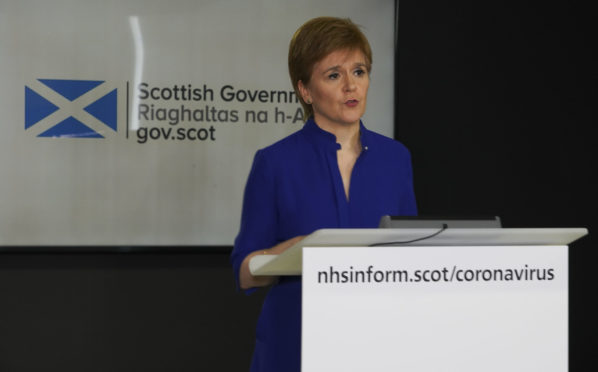Allowing people to meet up in social “bubbles” and having children split their time between school and home learning are among measures being considered by the Scottish Government to ease lockdown restrictions.
A new document published on Tuesday sets out measures being considered by ministers as part of a framework for decision making on coronavirus.
At her daily briefing in Edinburgh, first minister Nicola Sturgeon outlined “initial options” for loosening rules in place to help slow the spread of Covid-19 but warned “extreme caution” will need to be exercised to prevent services reaching crisis point.
The paper – broken down by The Press & Journal here – states lifting restrictions too early, such as reopening primary schools and nurseries fully at this stage, could see a new spike in infections which would overwhelm the NHS within two months.
The five key options being considered by the Scottish Government are:
- Changes to advice to allow people to leave their home more often and for longer periods of time while remaining in their local area.
- Creating social “bubbles” to allow people to meet with small numbers of others outside their household, possibly just outdoors initially. The exact number is not known and it would likely not be possible for those at high risk.
- Resuming certain elective procedures and screening services suspended during the outbreak, along with a phased reintroduction of a wider range of social care support such as therapeutic group activities.
- Reopening workplaces as soon as possible but only when it is safe to do so. Construction, manufacturing, retail, and rural work will be early focuses. Working from home is “likely to persist as part of the new normal” for many.
- A phased approach for returning pupils to school. Ministers “do not consider it likely” schools will reopen fully in the foreseeable future and are not yet certain they will reopen at all in the near future.
The paper notes the need for “a new approach to schooling”, likely with a blend of in-school and at-home learning. This would see pupils attend part-time to allow premises to be deep cleaned between sessions.
The Scottish Government could also develop a “chronological list of priority groups” to return to school in an agreed order. This would likely include children transitioning from primary to secondary, vulnerable pupils or those sitting exams.
Ms Sturgeon said a return to school “might not be possible at all ahead of the summer holidays”, adding “we will not compromise the safety of your children”.
She stressed the approach of the Scottish Government will ensure the country is “ready to make changes when the evidence says it is safe to do so”.
“To be clear with you, this is not a list of things we will definitely do by certain dates. Indeed we might not be able to take all of these steps even at the end of May,” she said.
“This is going to be a long process with different phases along the way and we will only implement these changes when it is as safe as possible to do so.
“In the meantime, it is vital that we stick rigorously to the current rules. It is important that we are preparing now.”
Ms Sturgeon also stressed the importance of keeping the R number – the number of people infected by each person who has the virus – below one.
The Scottish Government’s framework document states there is some evidence the current R number in Scotland is higher than elsewhere in the UK, with care homes and hospitals having higher reproduction rates than the general population.
Ms Sturgeon said this was likely because Scotland is at an earlier stage of the infection curve than England, which had the earliest confirmed cases in the UK.
The first minister said there were potentially 26,000 people in Scotland with Covid-19, “much too high at present to consider the virus under control”, and the best estimate is that the R number is somewhere between 0.7 and one.
“The fact is that any easing of restrictions, whenever we introduce them, will have an impact on the R number,” Ms Sturgeon said.
“But if we get our baseline lower than it is now, we will have more headroom to cope with that and be able to avoid outcomes like the one I just highlighted.”
The first minister was also asked about research from experts at Dundee University which suggests it would be “almost impossible” to return to normal life or raise activity above 10% of pre-lockdown levels until a vaccine is found.
Ms Sturgeon said she had not yet seen the research but the key findings sound “pretty much in line” with the Scottish Government’s considerations.
“This is not about flicking a switch and getting back to normal,” she said.
“This is about learning to live with the virus in a way that restores a degree of normality, more normality than we have got right now, but recognises that through physical distancing, continuing to reduce our contact with other people, things like face coverings, all of that is going to be necessary up to, potentially, the point that we’ve got a vaccine.”
Ms Sturgeon said the Scottish Government’s proposals were about finding a way to live with the virus without allowing it to overwhelm services.
She added: “That is not easy but these are the judgements we’re trying to make to find that particular formula as best we can that achieves that.”
